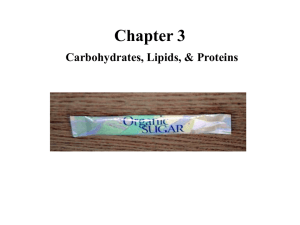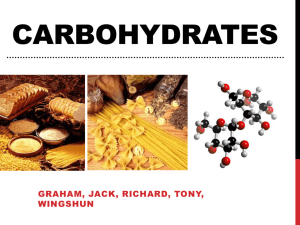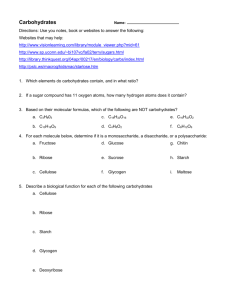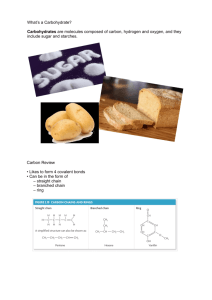Monosaccharides, Disaccharides, Polysaccharides, Sugars, Starches.
advertisement
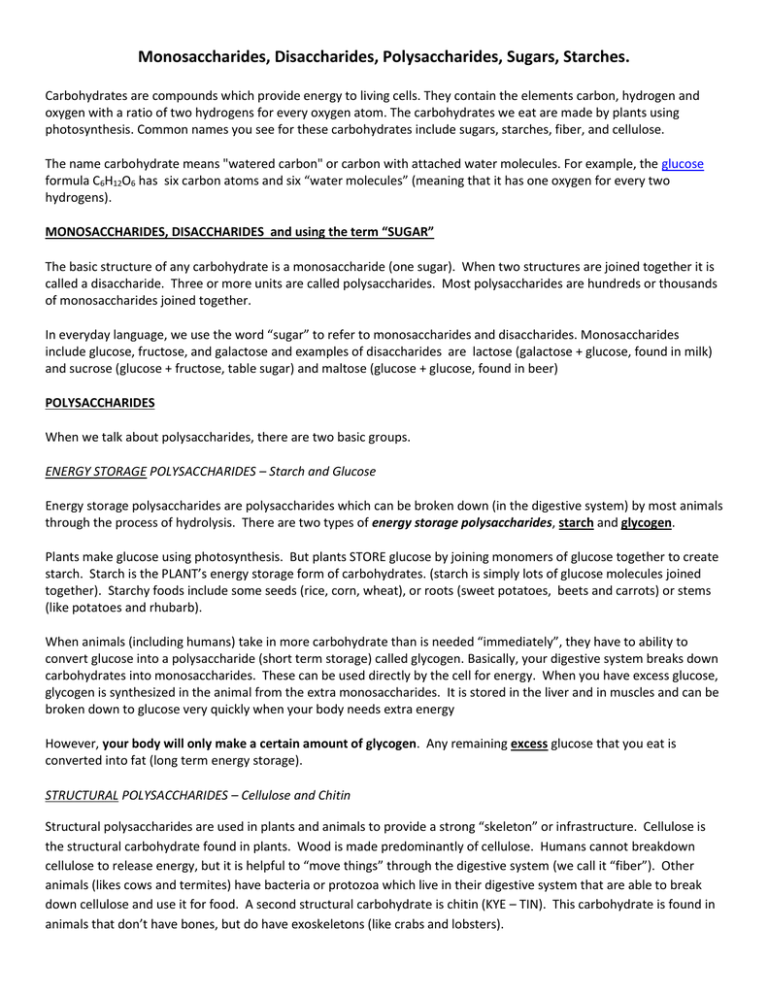
Monosaccharides, Disaccharides, Polysaccharides, Sugars, Starches. Carbohydrates are compounds which provide energy to living cells. They contain the elements carbon, hydrogen and oxygen with a ratio of two hydrogens for every oxygen atom. The carbohydrates we eat are made by plants using photosynthesis. Common names you see for these carbohydrates include sugars, starches, fiber, and cellulose. The name carbohydrate means "watered carbon" or carbon with attached water molecules. For example, the glucose formula C6H12O6 has six carbon atoms and six “water molecules” (meaning that it has one oxygen for every two hydrogens). MONOSACCHARIDES, DISACCHARIDES and using the term “SUGAR” The basic structure of any carbohydrate is a monosaccharide (one sugar). When two structures are joined together it is called a disaccharide. Three or more units are called polysaccharides. Most polysaccharides are hundreds or thousands of monosaccharides joined together. In everyday language, we use the word “sugar” to refer to monosaccharides and disaccharides. Monosaccharides include glucose, fructose, and galactose and examples of disaccharides are lactose (galactose + glucose, found in milk) and sucrose (glucose + fructose, table sugar) and maltose (glucose + glucose, found in beer) POLYSACCHARIDES When we talk about polysaccharides, there are two basic groups. ENERGY STORAGE POLYSACCHARIDES – Starch and Glucose Energy storage polysaccharides are polysaccharides which can be broken down (in the digestive system) by most animals through the process of hydrolysis. There are two types of energy storage polysaccharides, starch and glycogen. Plants make glucose using photosynthesis. But plants STORE glucose by joining monomers of glucose together to create starch. Starch is the PLANT’s energy storage form of carbohydrates. (starch is simply lots of glucose molecules joined together). Starchy foods include some seeds (rice, corn, wheat), or roots (sweet potatoes, beets and carrots) or stems (like potatoes and rhubarb). When animals (including humans) take in more carbohydrate than is needed “immediately”, they have to ability to convert glucose into a polysaccharide (short term storage) called glycogen. Basically, your digestive system breaks down carbohydrates into monosaccharides. These can be used directly by the cell for energy. When you have excess glucose, glycogen is synthesized in the animal from the extra monosaccharides. It is stored in the liver and in muscles and can be broken down to glucose very quickly when your body needs extra energy However, your body will only make a certain amount of glycogen. Any remaining excess glucose that you eat is converted into fat (long term energy storage). STRUCTURAL POLYSACCHARIDES – Cellulose and Chitin Structural polysaccharides are used in plants and animals to provide a strong “skeleton” or infrastructure. Cellulose is the structural carbohydrate found in plants. Wood is made predominantly of cellulose. Humans cannot breakdown cellulose to release energy, but it is helpful to “move things” through the digestive system (we call it “fiber”). Other animals (likes cows and termites) have bacteria or protozoa which live in their digestive system that are able to break down cellulose and use it for food. A second structural carbohydrate is chitin (KYE – TIN). This carbohydrate is found in animals that don’t have bones, but do have exoskeletons (like crabs and lobsters). Carbohydrates Worksheet – Bio H Name: 1. Which elements do carbohydrates contain, and in what approximate ratio? 2. If a sugar compound has 11 oxygen atoms, how many hydrogen atoms does it contain? 3. Based on their molecular formulas and the “ratio rule above”, which of the following are NOT carbohydrates? a. C3H803 c. C18H32O16 e. C16H32O2 b. C10H18O9 d. C4H8O2 f. C6H12O6 4. For each molecule below, identify it as a monosaccharide(M), a disaccharide,)D) or a polysaccharide(P). Fructose ______ Glucose ______ Chitin _______ Ribose ______ Sucrose ______ Starch _______ Cellulose ______ Glycogen ______ Maltose _______ 5. Which of the polysaccharides are found in plants?. Of these polysaccharides, which is “structural” and which is “food storage”? 6. Which of the following polysaccharides is found in animals? Of these polysaccharides, which is structural and which is storage? Chitin, cellulose, starch, glycogen 7. Provide a specific biological function for each of the following carbohydrates (you will need to look this up) a. Cellulose b. Ribose (hint, nucleic acids) c. Starch d. Glycogen e. Deoxyribose f. Fructose g. Sucrose The structures of the important monosaccharides are: Identify similarities and differences within in these structures. 8.Which monosaccharides have the same formulae? Do they have the same properties? 9.Which are a part of nucleic acids? Look at the names of these two carbohydrates. Based on their names, can you explain how they are different from each other? 10.Complete these word equations with the appropriate level response (ie if the name of a carb is given, provide a specific name for the new carb created. If a general term is used, provide a general term. a. Glucose + glucose b. Glucose + fructose c. Monosaccharide + monosaccharide d. Lactose + water e. Disaccharide + water 11. Briefly describe (in words and pictures) the process of the condensation reaction (dehydration synthesis) for carbohydrates. 12. Briefly describe the process of the hydrolysis reaction for carbohydrates. Create a summary table that describes the attributes of different carbohydrates Carbohydrate Monomers Dimers Energy polymers and location (plant or animal) “official name” “official name” “official name” ________________ ________________ _______________________________ 1. 1. Plant energy polysaccharide: 1. Made of: Repeating units of ____________________ 2. 2. 2. Plant structural polysaccharide Made of: Repeating units of ________________________ 3. 3. 3. Animal energy polysaccharide: Made of: Repeating units of________________________ 4. . Structural animal polysaccharide: Derivative of glucose Finally, look at the structures of these three polysaccharides. How are they different? How are they the same?


